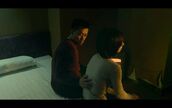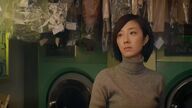A representative opinion is that "Fireworks in the Day" borrows so much from Western film noir that it becomes a stylistic exercise. There are also comments that even if it is evaluated by the standards of film noir, the film still has many shortcomings. Therefore, the core level of our discussion below is bound to touch on the relationship between the film and film noir, which is related to whether the film that was talked about at the time was underestimated in word of mouth.
Like the gray characters in his earlier works, Diao Yinan is very low-key, but he has been able to strongly feel his first-class literary qualities in a few interviews. Diao Yinan, who was born in the Department of Drama and Literature, talks about modern Western literary works very well. Literary literacy is of course a huge advantage for the creator, but in Diao Yinan's first two works, this advantage has turned into a huge flaw in the film. In "Night Train", which tells about desires that have nowhere to live, the characters' behaviors are inexplicably logical, and the narrative turnaround is very obscure and sluggish. This is a movie that requires the audience's infinite brains to make up for the extremely rich inner world of the characters. In literary works, one can exhaust all possibilities of the psychological world as old Russian writers, but in the world of images, unprovoked behaviors and dull expressions are far from enough. At least from this point of view, "Fireworks in the Day" successfully solves this problem.
On the surface, due to commercial pressure, "Fireworks in the Day" uses the shell of a genre film, but the narrative of the genre film makes the rich inner world of the characters shine on the outside. This is Diao Yinan's great breakthrough in self-deficiency. And compared with the previous two works, the editing of "Fireworks in the Day" is full of dramatic tension and evil charm. In the opening part, the close-up shots of the hand of the dismembered corpse and the hand of Zhang Zili (Liao Fan)'s ex-wife are cut together. There is a sense of deathly disillusionment here. Then there is the scene of Zhang Zili putting out the fire with a fire extinguisher, and the next scene is the scene of Wu Zhizhen ironing clothes with an electric iron. This is the connection between death, smoke, gas, and sex.
With the investigation of the corpse case as the core clue of the narrative, "Fireworks in the Day" is indeed a Chinese film with the strongest film noir meaning in recent years. Even if you don't pay attention to the plot, the formal sense of the image can be seen at a glance, which is a typical noir film. The artificial and staged strong color contrast is the most typical lighting method for film noir. This lighting method can produce a highly dramatic atmosphere space. Characters survive in such space activities, and their inner struggles, fears, and anxiety flicker outside from time to time. In the tension of the plot, there is an impulse to break out incredible actions at any time. The lighting in "Fireworks by Daylight" completely replicates this approach. But what is special is that the film has both the contrast of light in the color part and the contrast of black and white - black coal and white snow. Another point worth mentioning in the color section is the influence of Vertigo. Like Vertigo, the film uses red-green primary colors. In Vertigo, red represents desire and passion, and green represents death and ghosts. The colors of "Fireworks in the Day" are often red and green, and Wu Zhizhen's sweater is also replaced with red and green. "Fireworks in the Day" has the same motif as "Vertigo". Men are so obsessed with women's bodies that they are willing to turn into ghosts.
There are also many commenters who pointed out the huge influence of "The Third Man" on "Fireworks by Daylight". The film's climax scene of the Ferris wheel is indeed a direct reference to "The Third Man". The plot that draws characters in like a vortex is also a major feature of film noir, and the turbulent plot of "Fireworks in the Day" also meets this standard. But is this really just a style practice work that follows a gourd and draws a scoop and imitates it?
Western film noir has an important social foundation—the Cold War. The potential nuclear explosion crisis in the Cold War era and the crisis of the Third World War have determined the core theme of Western film noir: the sense of despair for the future and the fatalism of being unable to grasp oneself. The protagonists who are in a state of despair and cannot escape in the film noir are all victims of this half-century-long global crisis that has subtly affected their souls. If you don't consider this social background and just copy the form and plot, it is really just a copy. In this sense, "Fireworks in the Day" is by no means a crime movie with an empty social foundation. The film has a profound social and historical background, and this background is not directly revealed in the film.
Diao Yinan's choice of the Northeast at the turn of the century as the place where the story takes place determines the legitimacy and inevitability of the despairing core of this noir film. Northeast China is not only despairing because of the extreme cold in geographical space, but also caused huge social changes after the tide of reform in the 1990s, which directly changed the temperament of the Northeast. A society that was completely composed of the state-owned economy in history needs to be transformed into a private economy due to the country's strategic industrial structure adjustment. The huge pain, sorrow, fear and despair caused by this transformation process are the most internalization of film noir. social sentiment. This overall social mood has a profound impact on the state of the characters in the film.
The three protagonists Zhang Zili, Liang Zhijun (Wang Xuebing), and He Mingrong (Wang Jingchun) in "Fireworks in the Day" are all failures in life, either abandoned by their wives, or willing to take the blame for their wives, or the loss of sexual function leads to desire deformity. The three of them were struggling and resisting, and they were unwilling to do so. The role of Liang Zhijun is particularly special. When he first appeared, he was wearing skate shoes. According to typical psychoanalytic theory, ice skating means castration, loss of sexual function. Liang Zhijun chose a self-destructive physical seclusion for his beloved wife. For many years, he could only exist like a ghost. On the metaphorical level, he is like a historical burden that will eventually be thrown off.
Wu Zhizhen was criticized by some critics for not conforming to the temperament of the typical femme fatale in film noir. Everything she does is passive. Her murder was passive, and her entanglement with He Mingrong and Zhang Zili happened passively. Her mysterious and charming temperament is enough, but she lacks the lewd temperament of Lana Turner in "The Postman Always Rings Twice" or Rita Hayworth in "Miss Shanghai". But the problem is that femme fatale does not meet the standard of western film noir, which is not film noir? In fact, in the long run, film noir was originally the theoretician's hindsight, and no filmmakers in those days would take the initiative to make a film noir. It is easy for latecomers to make movies according to the formula, and it is easy to become a slap in the face. Genre films are always the result of the self-evident tacit interaction of social ideology, film technology, aesthetic evolution and the audience.
On the other hand, in fact, the black despairing temperament of the entire movie "Fireworks in the Day" permeates all the characters, including Wu Zhizhen. She was meant to be a victim. Murdering and dismembering the corpse is an act of helpless and forced resistance. But resistance is futile after all, fate is like a skynet binding her, and there are always male hunters chasing her and biting her. This is true black temperament.
The Northeast historical narrative mixed with black crimes in "Fireworks in the Daytime" is also related to Diao Yinan's special spatial interest. Diao Yinan particularly likes to photograph public spaces with a strong pre-socialist-planned economy temperament: dance halls, buses, short-distance trains, ice rinks. He is especially sensitive to the hidden and obscure desires that individuals sometimes reveal in this public space for a long time. In "Uniform" and "Night Train", he also links this desire to power. The desires of "Fireworks in the Day" are also unfolded in these spaces. Diao Yinan also likes to shoot walking scenes with tracking. There are also a lot of tracking scenes in "Fireworks in the Day". Tracking means peeking, confronting, dodging, and the emotional urge to move your body. And this ultimately points to the possibility of escape, the ultimate narrative of film noir. The climax of the Ferris wheel represents the inescapable and desperate confirmation of the fate of reincarnation. Wu Zhizhen's glamorous face was illuminated by the flickering light, and all that awaited her were sex and death.
Diao Yinan also injected a lot of imagery into "Fireworks in the Day", which is the advantage of a director with a literary background. The plastic bags fluttering in the wind, the yellow insects on the white cloth when Zhang Zili was having sex with his ex-wife, the horses that intruded inexplicably, the Ferris wheel—all these images have played a role in the externalization of the characters' inner world, and they are also what Diao Yinan overcomes the shortcomings of his previous works. Performance. But the most important imagery must be the daytime fireworks. This image greatly enriches the expression of the film's narrative, characters and motifs. Fireworks should be released at night to be bright and gorgeous. During the day, fireworks have only a kind of empty sternness. If you are negative, they are serious, and if you are pessimistic, they are desperate struggles and ineffective release of desires. In this sense, it is also black.
The most successful thing about "Fireworks in the Day" is that it successfully combines a horrific and brutal crime incident with an aesthetic and historical geographical space at the overall level, forming a set of effective black desire expression matrix, which is very popular in China. It is a very rare case in film history.
(It has been published in the column on the evil theory of the iris official account)
View more about Black Coal, Thin Ice reviews











